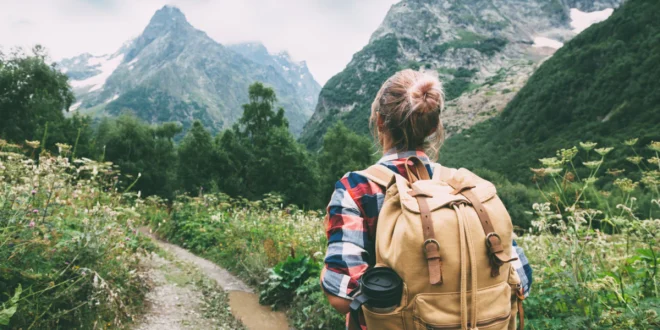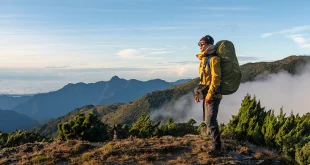When planning a backpacking trip, one of the most exciting but challenging parts of the process is choosing the right route. Over the years, I’ve learned that selecting the right trail can make or break your entire experience. I’ve made plenty of mistakes in the past, but with time, I’ve figured out how to choose a backpacking route that aligns with my goals, skills, and the kind of adventure I’m looking for. In this guide, I’ll share the process that I now follow when deciding on a backpacking route, and I hope it helps you plan your next great outdoor adventure.
Understanding Your Personal Experience Level
One of the first things I consider when figuring out how to choose a backpacking route is my experience level. A few years ago, I took on a trail that was far more difficult than I was prepared for, and it ended up being more stressful than enjoyable. Now, I carefully assess my fitness level and skill set to ensure I pick a trail that matches my current abilities.
For beginners, it's crucial to pick shorter, less demanding trails that offer manageable elevation gain and well-marked paths. As I gained more experience, I started tackling longer routes with more challenging terrains, but I always made sure to start slow and progressively increase the difficulty of the hikes I selected. If you’re new to backpacking, start with a weekend trip and gradually build your confidence. You’ll be surprised at how quickly your endurance and comfort levels improve.
Evaluating the Terrain and Elevation
The terrain and elevation of a backpacking route are key factors to consider when planning your trip. In my early days of hiking, I underestimated how much these factors could affect the difficulty of a route. Now, I always take the time to research a trail’s topography to avoid unpleasant surprises.
A route with consistent elevation gain can be grueling over time, while trails with fluctuating elevation can be challenging in different ways. For example, a mountainous trail with steep ascents and descents can be exhausting, but the views and the sense of accomplishment make the effort worth it. In contrast, a trail with moderate slopes and scenic valleys might be easier physically, but it can still offer plenty of beauty and excitement.
One thing I’ve learned is to study the trail’s map and elevation profile before heading out. This helps me prepare both physically and mentally for the challenges I’ll face. You don’t want to be surprised by a sudden steep climb when you’re already several miles into your journey.
Timing Your Trip Based on Seasonal Conditions
Choosing the right time of year for your backpacking trip is another crucial step. As I’ve experienced, different trails have different accessibility depending on the season, and picking the wrong time can lead to dangerous conditions or missed opportunities for exploration.
For example, in high-altitude areas, snow can linger well into spring, and some trails may still be impassable in early summer. On the other hand, desert routes can be brutally hot in the summer, making them uncomfortable and unsafe for long hikes. I’ve learned to plan trips based on the expected weather and trail conditions by checking reports from reliable sources, like the National Park Service or local hiking forums.
If you’re hiking in a region known for unpredictable weather, it’s best to keep an eye on trail conditions leading up to your trip. Many parks and trail organizations provide real-time information about closures, mudslides, or snowmelt, and staying informed can help you avoid any surprises.
Factoring in the Length of the Trail and the Time Available
When I’m deciding how to choose a backpacking route, I also consider the time I have available. Some routes are designed for quick weekend trips, while others require weeks of planning and preparation. The length of the trail and the number of days you plan to spend on the trail can have a huge impact on your overall experience.
If you’re just starting out, a shorter, more manageable route is the best choice. For example, many national parks offer well-established loops that can be hiked in two to three days. I started with these shorter loops to familiarize myself with the packing, preparation, and hiking pace required for multi-day trips. As my confidence grew, I started tackling longer routes and even some through-hikes that took a week or more to complete.
A common rule for backpackers is to plan on averaging about 8 to 12 miles per day on moderate terrain. For rougher trails, though, I’ve found that adjusting expectations and reducing mileage helps maintain energy levels and makes the trip more enjoyable.
Considering the Type of Wilderness and Its Unique Features
Different types of wilderness environments offer distinct challenges, and I’ve found that knowing what to expect can make all the difference in how enjoyable the hike is. Forests, deserts, and mountainous regions each come with their own set of opportunities and potential pitfalls.
For example, when I hike through desert landscapes, I always keep in mind that water sources can be scarce. The dry, arid climate means that I need to be prepared to carry a large amount of water, especially for longer hikes. In contrast, when I hike through forests or along rivers, water tends to be more readily available, but there are always considerations like water purification and managing the risk of contamination.
Wildlife encounters are also something I keep in mind when selecting a route. In some areas, like parts of Canada and the northern U.S., you’ll find bears, while in the Rockies, moose can be common. I’ve had several encounters with wildlife, and being prepared with bear-safe food storage and proper precautions can help minimize risks and ensure a safe experience.
Preparing for Trail Access and Permits
Before I choose a route, I also research how accessible the trail is, especially when it comes to permits. Many of the popular trails I’ve hiked require advance reservations or permits for overnight camping. In some national parks or protected areas, these permits are issued on a first-come, first-served basis, while others require a lottery system.
I’ve encountered situations where I couldn’t access a trail because I didn’t secure a permit in advance, and this taught me the importance of researching permit requirements before heading out. I now make sure to plan ahead by checking the necessary websites and reserving permits as early as possible.
Additionally, some trails are more remote and may require long drives or access via unpaved roads. Knowing the trailhead’s location and how to get there can save you time and frustration when you arrive. Many trailheads require parking passes or have limited spaces, so it’s always wise to plan accordingly.
Conclusion
Deciding how to choose a backpacking route isn’t a one-size-fits-all process—it’s about finding a trail that suits your skills, interests, and goals. Whether you're a beginner just getting started or an experienced backpacker looking for your next adventure, taking the time to research and carefully choose a route will make your experience far more enjoyable.
By considering factors like your skill level, terrain, seasonal conditions, trail length, and the type of wilderness you’re hiking through, you can confidently plan a backpacking trip that’s both rewarding and safe. Remember, every trail offers something unique, and the key is to match the right route to your personal needs and preferences. Happy hiking!
 Best Hiking Gear Hike More, Worry Less
Best Hiking Gear Hike More, Worry Less

